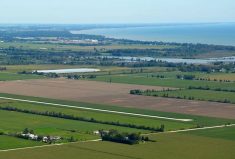Glacier FarmMedia – Pressures on commodity fertilizer prices are similar to those on grains and oilseeds. Supply isn’t meeting demand and costs are up. Some farm groups and many producers question the legitimacy of rising costs and they want answers.
Prices in Canada for urea have more than tripled in the past two years and so have those for UAN. Anhydrous ammonia has nearly quadrupled and some sellers predict it might double again. Phosphorus has doubled in price and potash has nearly tripled. Fertilizer makers are showing strong profit pictures to their investors.
It might seem reasonable for producers to ask the government to examine input costs and fertilizer companies. But while prices seem out of line with previous years, they are in keeping with international ones.
Read Also

Footflats Farm recognized with Ontario Sheep Farmers’ DLF Pasture Award
Gayla Bonham-Carter and Scott Bade, of Footflats Farm, win the Ontario Sheep Farmers’ 2025 DLF Ontario Pasture Award for their pasture management and strategies to maximize production per acre.
Since September, the price of urea at Black Sea ports has jumped by US$480 per tonne to a current high of $900. This might be a good benchmark to consider when looking at the current farm experience.
In December 2020, farmers in western Canada paid about C$550 per tonne for 46-0-0. A month ago, the price was $1,150. At the same time, urea in the Black Sea region was US$265 and rose to $900. Issues in central Europe might soon distort figures there, but for the time being it shows that increases in input costs are global.
From a low of $65 per tonne for urea in August 1999 to peaks of $785 in 2008 (which collapsed to $240 by the end of that year), global prices in the past 20 years tend to trade in a range between $200 and $350.
Canadian prices have shuffled between C$460 and $600 within the last five years. Anhydrous in the same period moved between $750 and $900 for a full-service deal with the applicator.
From 1982 to 1993, fertilizer prices were depressed when former USSR countries dumped product in a struggle for export income. At the same time the developing world was dealing with a debt crisis and global interest rates crippled the ability to invest in crop nutrients.
Rising natural gas prices in the mid-1990s, which also saw rising crop commodity prices and the fall of the Soviet Union, increased both demand and fertilizer prices.
Today, transportation bottlenecks and shortages, as well as demand from improving economies, factor into prices. China’s decision to restrict fertilizer exports is playing a significant role. Natural gas, the key component in nitrogen fertilizer, has been trading in a tight and low range for a decade, with only a few exceptions.
Major fertilizer plants in the United States’ Gulf region have been down due to storm damage and one in Alberta was recently offline as well.
While there is competition for fertilizer, there aren’t many manufacturers or miners and those have fairly inflexible production levels. New capacity or increases in current production require investment, staff and, of course, time.
The forces exerted on input prices tell the tale but beyond that, crop commodity prices and farm profitability also influence providers. Farmers see record-setting prices for the 2022 season and plan to make what may be the largest investment in a spring crop in Canadian history.
Are strong profits being taken on fertilizer this year? Yes.
Do we need a government inquiry? No.
The cure for high prices is generally high prices.
– This article was originally published at The Western Producer.














